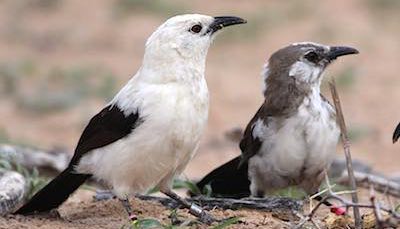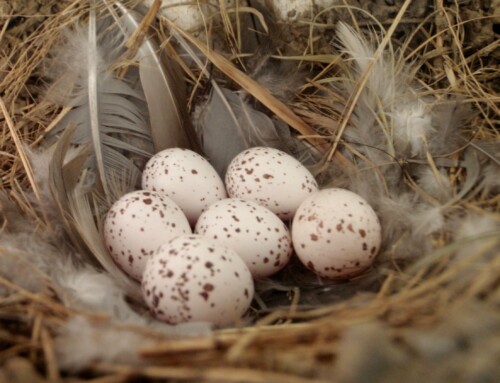Does fledgling survival in the weeks after leaving the nest increase with nestling development time and adult survival among songbirds?
LINKED PAPER
Fledgling survival increases with development time and adult survival across north and south temperate zones. Lloyd, P. & Martin, T.E. 2015. IBIS. DOI: 10.1111/ibi.12325 VIEW
When they first leave the nest, most young songbirds have only partially developed wings and can barely fly. Tumbling from the relative safety of the nest into unfamiliar surroundings, the ungainly fledglings are an easy target for a diversity of predators until their feathers and muscles become fully developed. Consequently, mortality can be high during their first few weeks of mobility. This mortality risk suggests there should be strong selection for attributes that increase fledgling survival. Until recently, there has been limited investigation of what these attributes might be.
Wing development is an obvious candidate for improving fledgling survival as it is critical for a bird’s mobility and ability to escape from predators. Therefore, one tactic is to allow nestlings to develop longer in the nest so that their wings are better developed when they eventually leave (Martin 2014). However, this option can be constrained by nest predation risk. It is better for nestlings to leave the nest sooner when the risk of nest predation is high (Martin 1995).
Differences in the life history strategies adopted by different species might also influence fledgling survival. Life history strategies differ most markedly between birds inhabiting the north-temperate zone, where the climate varies dramatically between summer and winter seasons, and the tropics, where the climate is more stable. Tropical songbirds typically lay smaller clutches of eggs and experience lower adult mortality than relatives in the north-temperate zone. Associated with their higher adult survival and smaller clutches, tropical songbirds make fewer feeding trips to the nest, meaning that they don’t work as hard raising their young. Nevertheless, because of smaller clutches in the tropics, each tropical nestling receives more food than each north-temperate nestling, which translates into faster wing growth in tropical species (Martin 2015). While this leads to the prediction that fledgling survival should be greater among tropical species, it has yet to be tested.
South-temperate songbirds exhibit life histories that are similar to tropical species, and fledgling survival has been studied among diverse species in the south-temperate zone. So, we decided to focus on a comparison of north-temperate with south-temperate zone songbirds to test the idea of higher fledgling survival in the south.
As part of a broader study of life history evolution (Martin et al. 2006, 2007, 2011, 2015a, 2015b, Lloyd et al. 2014), we monitored the survival of 647 colour-banded fledglings of eight different songbird species after leaving the nest in south-temperate South Africa. Our ability to monitor fledglings was greatly assisted by two features of the study area in Koeberg Nature Reserve, north of Cape Town. First, all species were residents that occupied year-round territories, so the parents did not disperse with the young after fledging and could be reliably located. Second, the habitat was a low, open shrubland, so the birds were easy to observe. Despite unusually high nest predation rates that averaged nearly 9% per day across the South African bird community as a whole (Martin et al. 2006), fledgling survival through the first three weeks was high, ranging from 77% in the Karoo Scrub-Robin to 97% in the Cape Penduline Tit.

We combined our estimates of fledgling survival with those from published studies to give a sample of 28 south-temperate and 37 north-temperate songbird species for comparison. We found strong evidence that longer development time in the nest promotes greater fledgling survival across both north-temperate and south-temperate species, as predicted if birds fledge with better developed wings after longer development time in the nest (Martin 2014, 2015). The Cape Penduline Tit provides a case in point. Fledgling survival of 97% is unusual for a small bird weighing just six grams that fledges broods of up to six young, but the elaborate nest that this species constructs results in very low nest predation risk. This allows the nestlings to remain in the nest for at least a week longer than any other species in the community we studied. Consequently, the young fly strongly on fully developed wings when they venture from the nest for the first time.

Controlling for nest development time, we found that fledgling survival was greater among species with greater adult survival. Adult survival also correlated negatively with clutch size, meaning that longer-lived birds laid smaller clutches. This result supports the prediction that reproductive investment by longer-lived birds focusses on strategies that enhance the quality of offspring without compromising adult survival. These strategies are facilitated by reducing the number of offspring per breeding attempt (Martin 2015).

In our comparative analysis, fledgling survival by the end of the first three weeks averaged 86% among south-temperate species, contrasting with average fledgling survival of 62% among north-temperate species. Our study adds to the growing body of evidence showing that south-temperate birds adopt life-history strategies that trade-off reduced offspring numbers with increased offspring quality to promote both adult and juvenile survival.

References and further reading
Lloyd, P., Abadi, F., Altwegg, R. & Martin, T.E. 2014. South temperate birds have higher apparent adult survival than tropical birds in Africa. Journal of Avian Biology 45: 493-500. View
Martin, T. E. 1995. Avian life history evolution in relation to nest sites, nest predation and food. Ecological Monographs 65: 101–127. View
Martin, T.E. 2014. A conceptual framework for clutch-size evolution in songbirds. American Naturalist 183: 313-324. View
Martin, T.E. 2015. Age-related mortality explains life history strategies of temperate and tropical songbirds. Science 349: 966-970. View
Martin, T.E., Auer, S.K., Bassar, R.D., Niklison, A.M. & Lloyd, P. 2007. Geographic variation in avian incubation periods and parental influences on embryonic temperature. Evolution 61: 2558-2569. View
Martin, T.E., Bassar, R.D., Bassar, S.K., Fontaine, J.J., Lloyd, P., Mathewson, H.A., Niklison, A.M. & Chalfoun, A. 2006. Life-history and ecological correlates of geographic variation in egg and clutch mass among passerine species. Evolution 60: 390-398. View
Martin, T.E., Lloyd, P., Bosque, C., Barton, D.C., Biancucci, A.L., Cheng, Y.-R. & Ton, R. 2011. Growth rate variation among passerine species in tropical and temperate sites: an antagonistic interaction between parental food provisioning and nest predation risk. Evolution 65: 1607-1622. View
Martin, T.E., Oteyza, J.C., Boyce, A.J., Lloyd, P. & Ton, R. 2015. Adult mortality probability and nest predation rates explain parental effort in warming eggs and embryo development time. American Naturalist 186: 223-236. View
Martin, T. E., Oteyza, J. C., Mitchell, A. E., Potticary, A. L., & Lloyd, P. 2015. Postnatal growth rates covary weakly with embryonic development rates and do not explain adult mortality probability among songbirds on four continents. American Naturalist 185: 380-389. View
Image credit
Featured image: Cape Penduline Tit © Craig Adam
If you want to write about your research in #theBOUblog, then please see here.





